Convolutional Neural Networks
for Visual Recognition
Feifei Li
CS231n, Stanford Open Course
�
Edited by fengfu-chris, email: fengfu0527@gmail.com
Copyright: Stanford Vision Group
Contents
Part I: Neural Networks
1.1 - Image Classification: Data-driven Approach, k-Nearest Neighbor, train/val/test splits ------- 3
1.2 - Linear classification: Support Vector Machine, Softmax ------------------------------------------ 19
1.3 - Optimization: Stochastic Gradient Descent ---------------------------------------------------------- 37
1.4 - Backpropagation, Intuitions ---------------------------------------------------------------------------- 51
1.5 - Neural Networks Part 1: Setting up the Architecture ----------------------------------------------- 60
1.6 - Neural Networks Part 2: Setting up the Data and the Loss ---------------------------------------- 73
1.7 - Neural Networks Part 3: Learning and Evaluation -------------------------------------------------- 89
1.8 - Putting it together: Minimal Neural Network Case Study ---------------------------------------- 109
Part II: Convolutional Neural Networks
2.1 - Convolutional Neural Networks: Architectures, Convolution & Pooling Layers ------------- 123
2.2 - Understanding and Visualizing Convolutional Neural Networks ------------------------------- 146
2.3 - Transfer Learning and Fine-tuning Convolutional Neural Networks --------------------------- 152
2.4 - ConvNet Tips and Tricks: squeezing out the last few percent ----------------------------------- 155
Part X: Preparation
x.1 - Python Numpy Tutorial ------------------------------------------------------------------------------- 156
x.2 - IPython Tutorial ---------------------------------------------------------------------------------------- 182
x.3 - Terminal ------------------------------------------------------------------------------------------------- 186
�
CS231n Convolutional Neural Networks for Visual
Recognition
These notes accompany the Stanford CS class CS231n: Convolutional Neural Networks
for Visual Recognition. Feel free to ping @karpathy if you spot any mistakes or issues,
or submit a pull request to our git repo.
We encourage the use of the hypothes.is extension to annote comments and discuss
these notes inline.
Assignments
Assignment #1: Image Classification, kNN, SVM, Softmax
Assignment #2: Neural Networks, ConvNets I
Assignment #3: ConvNets II, Transfer Learning, Visualization
Module 0: Preparation
Python / Numpy Tutorial
IPython Notebook Tutorial
Terminal.com Tutorial
Module 1: Neural Networks
Image Classification: Data-driven Approach, k-Nearest Neighbor,
train/val/test splits
L1/L2 distances, hyperparameter search, cross-validation
Linear classification: Support Vector Machine, Softmax
parameteric approach, bias trick, hinge loss, cross-entropy loss, L2 regularization, web
demo
Optimization: Stochastic Gradient Descent
optimization landscapes, local search, learning rate, analytic/numerical gradient
Backpropagation, Intuitions
chain rule interpretation, real-valued circuits, patterns in gradient flow
Neural Networks Part 1: Setting up the Architecture
1�
model of a biological neuron, activation functions, neural net architecture,
representational power
Neural Networks Part 2: Setting up the Data and the Loss
preprocessing, weight initialization, regularization, dropout, loss functions in the wild
Neural Networks Part 3: Learning and Evaluation
gradient checks, sanity checks, babysitting the learning process, momentum
(+nesterov), second-order methods, Adagrad/RMSprop, hyperparameter optimization,
model ensembles
Putting it together: Minimal Neural Network Case Study
minimal 2D toy data example
Module 2: Convolutional Neural Networks
Convolutional Neural Networks: Architectures, Convolution / Pooling Layers
layers, spatial arrangement, layer patterns, layer sizing patterns,
AlexNet/ZFNet/VGGNet case studies, computational considerations
Understanding and Visualizing Convolutional Neural Networks
tSNE embeddings, deconvnets, data gradients, fooling ConvNets, human comparisons
Transfer Learning and Fine-tuning Convolutional Neural Networks
ConvNet Tips and Tricks: squeezing out the last few percent
multi-scale, model ensembles, data augmentations
Module 3: ConvNets in the wild
Other Visual Recognition Tasks: Localization, Detection, Segmentation
ConvNets in Practice: Distributed Training, GPU bottlenecks, Libraries
cs231n
cs231n
karpathy@cs.stanford.edu
2�
CS231n Convolutional Neural Networks for Visual
Recognition
This is an introductory lecture designed to introduce people from outside of Computer
Vision to the Image Classification problem, and the data-driven approach. The Table of
Contents:
Intro to Image Classification, data-driven approach, pipeline
Nearest Neighbor Classifier
k-Nearest Neighbor
Validation sets, Cross-validation, hyperparameter tuning
Pros/Cons of Nearest Neighbor
Summary
Summary: Applying kNN in practice
Further Reading
Image Classification
Motivation. In this section we will introduce the Image Classification problem, which is
the task of assigning an input image one label from a fixed set of categories. This is one
of the core problems in Computer Vision that, despite its simplicity, has a large variety
of practical applications. Moreover, as we will see later in the course, many other
seemingly distinct Computer Vision tasks (such as object detection, segmentation) can
be reduced to image classification.
Example. For example, in the image below an image classification model takes a single
image and assigns probabilities to 4 labels, {cat, dog, hat, mug}. As shown in the image,
keep in mind that to a computer an image is represented as one large 3-dimensional
array of numbers. In this example, the cat image is 248 pixels wide, 400 pixels tall, and
has three color channels Red,Green,Blue (or RGB for short). Therefore, the image
consists of 248 x 400 x 3 numbers, or a total of 297,600 numbers. Each number is an
integer that ranges from 0 (black) to 255 (white). Our task is to turn this quarter of a
million numbers into a single label, such as "cat".
3�
The task in Image Classification is to predict a single label (or a distribution over labels as shown
here to indicate our confidence) for a given image. Images are 3-dimensional arrays of integers
from 0 to 255, of size Width x Height x 3. The 3 represents the three color channels Red, Green,
Blue.
Challenges. Since this task of recognizing a visual concept (e.g. cat) is relatively trivial
for a human to perform, it is worth considering the challenges involved from the
perspective of a Computer Vision algorithm. As we present (an inexhaustive) list of
challenges below, keep in mind the raw representation of images as a 3-D array of
brightness values:
Viewpoint variation. A single instance of an object can be oriented in many ways
with respect to the camera.
Scale variation. Visual classes often exhibit variation in their size (size in the real
world, not only in terms of their extent in the image).
Deformation. Many objects of interest are not rigid bodies and can be deformed
in extreme ways.
Occlusion. The objects of interest can be occluded. Sometimes only a small
portion of an object (as little as few pixels) could be visible.
Illumination conditions. The effects of illumination are drastic on the pixel level.
Background clutter. The objects of interest may blend into their environment,
making them hard to identify.
Intra-class variation. The classes of interest can often be relatively broad, such as
4�
chair. There are many different types of these objects, each with their own
appearance.
A good image classification model must be invariant to the cross product of all these
variations, while simultaneously retaining sensitivity to the inter-class variations.
Data-driven approach. How might we go about writing an algorithm that can classify
images into distinct categories? Unlike writing an algorithm for, for example, sorting a
list of numbers, it is not obvious how one might write an algorithm for identifying cats in
images. Therefore, instead of trying to specify what every one of the categories of
interest look like directly in code, the approach that we will take is not unlike one you
would take with a child: we're going to provide the computer with many examples of
each class and then develop learning algorithms that look at these examples and learn
about the visual appearance of each class. This approach is referred to as a data-driven
approach, since it relies on first accumulating a training dataset of labeled images. Here
is an example of what such a dataset might look like:
5�
An example training set for four visual categories. In practice we may have thousands of
categories and hundreds of thousands of images for each category.
The image classification pipeline. We've seen that the task in Image Classification is to
take an array of pixels that represents a single image and assign a label to it. Our
complete pipeline can be formalized as follows:
Input: Our input consists of a set of N images, each labeled with one of K different
classes. We refer to this data as the training set.
Learning: Our task is to use the training set to learn what every one of the classes
looks like. We refer to this step as training a classifier, or learning a model.
Evaluation: In the end, we evaluate the quality of the classifier by asking it to
predict labels for a new set of images that it has never seen before. We will then
compare the true labels of these images to the ones predicted by the classifier.
Intuitively, we're hoping that a lot of the predictions match up with the true
answers (which we call the ground truth).
Nearest Neighbor Classifier
As our first approach, we will develop what we call a Nearest Neighbor Classifier. This
classifier has nothing to do with Convolutional Neural Networks and it is very rarely
used in practice, but it will allow us to get an idea about the basic approach to an image
classification problem.
Example image classification dataset: CIFAR-10. One popular toy image classification
dataset is the CIFAR-10 dataset. This dataset consists of 60,000 tiny images that are 32
pixels high and wide. Each image is labeled with one of 10 classes (for example
"airplane, automobile, bird, etc"). These 60,000 images are partitioned into a training set
of 50,000 images and a test set of 10,000 images. In the image below you can see 10
random example images from each one of the 10 classes:
6�
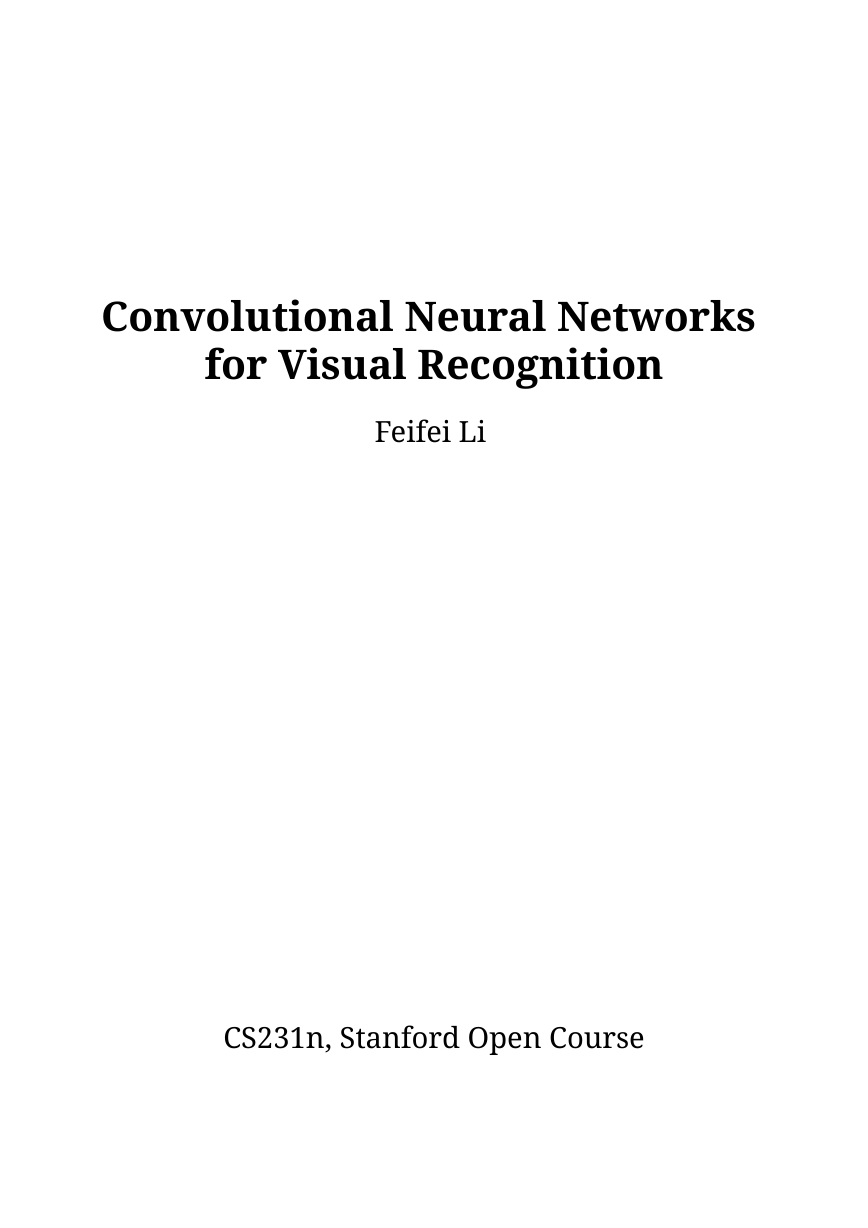
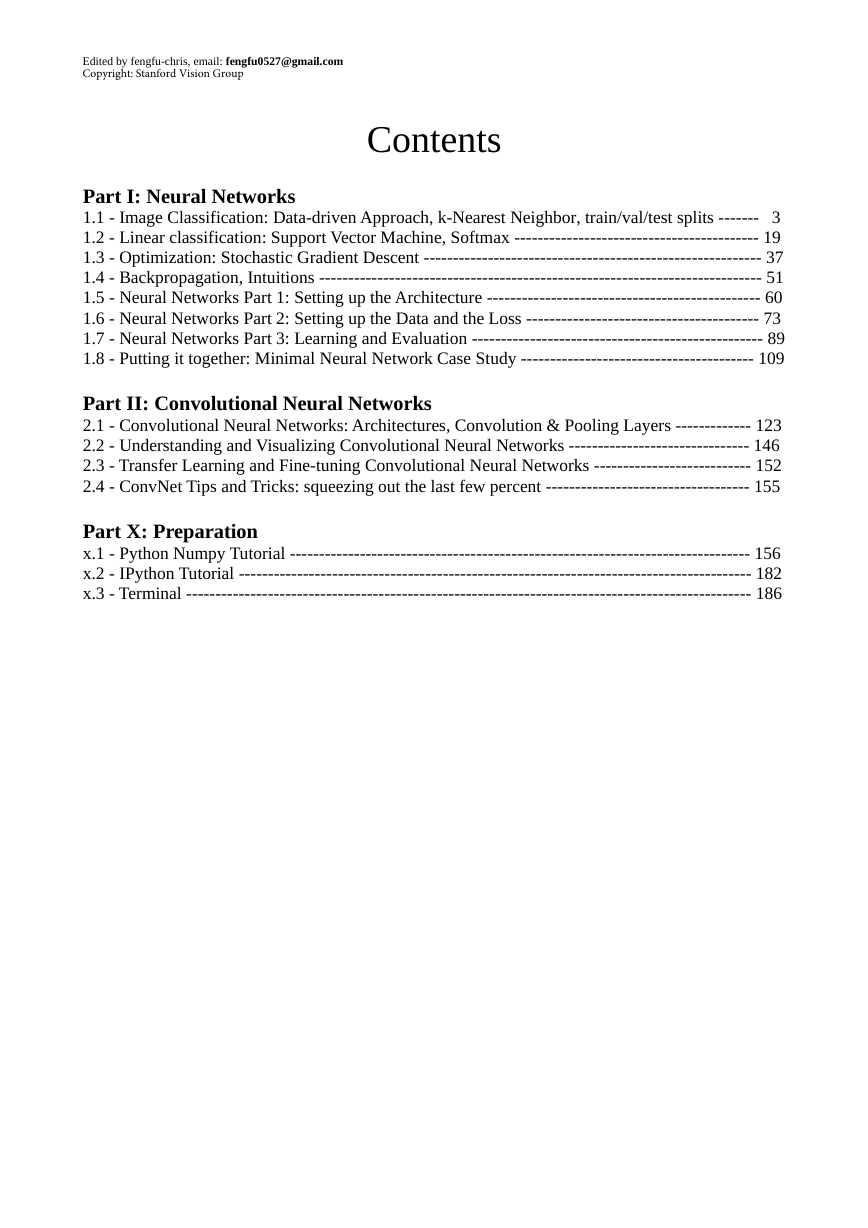


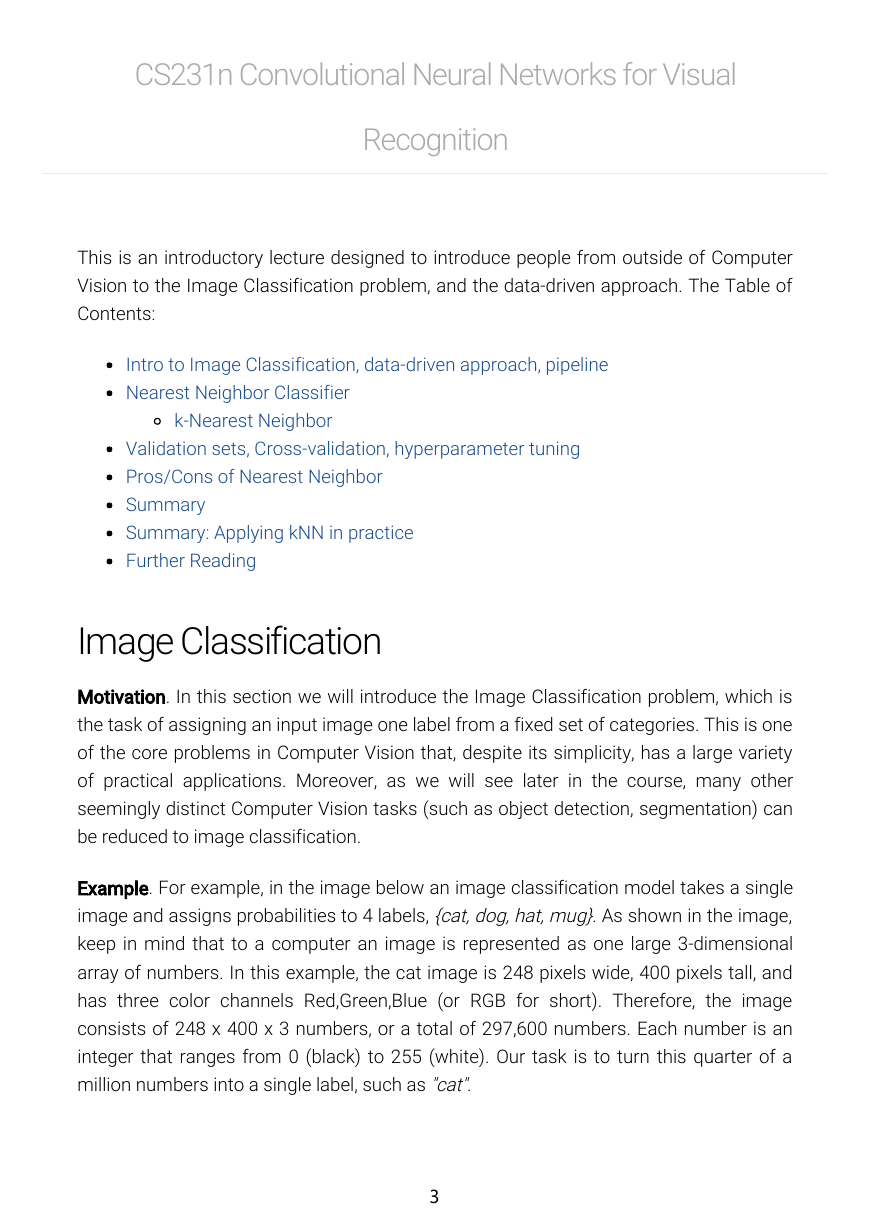
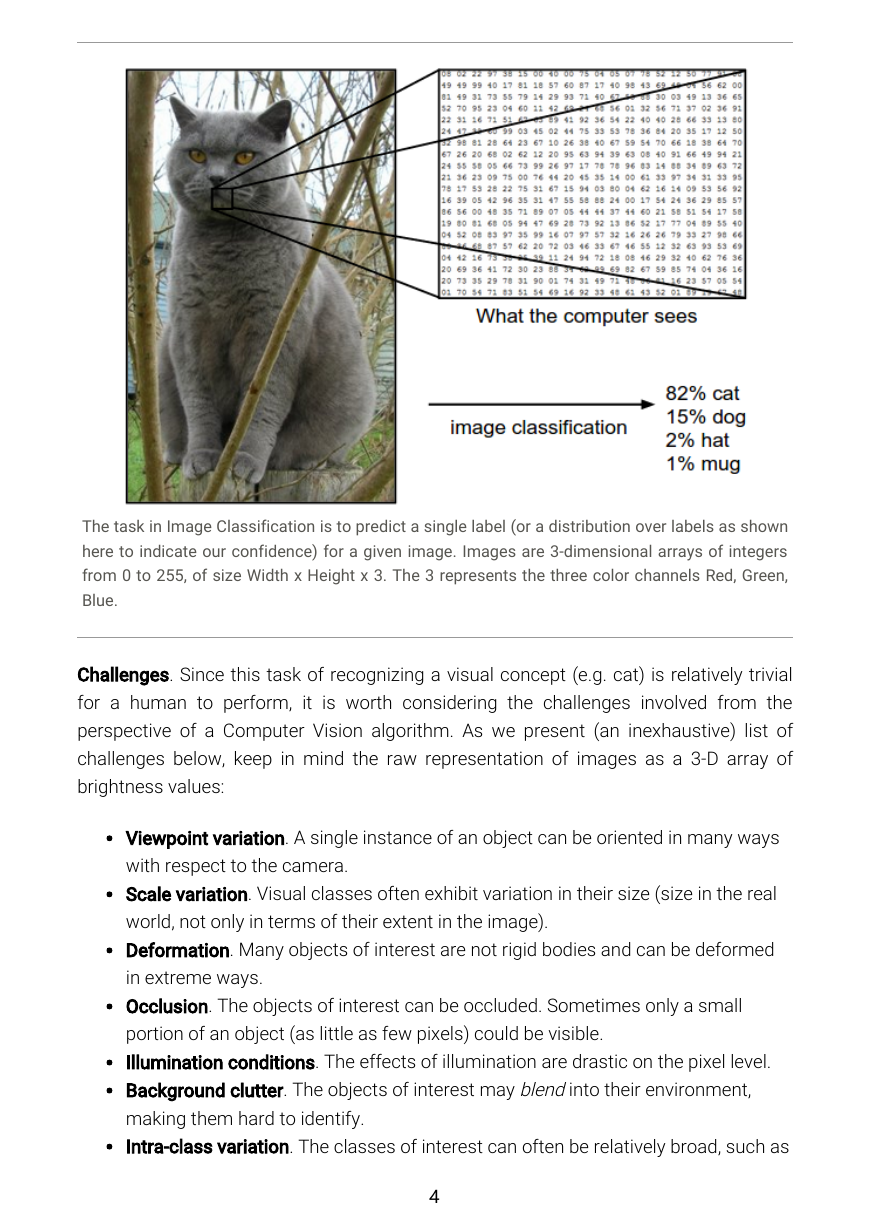
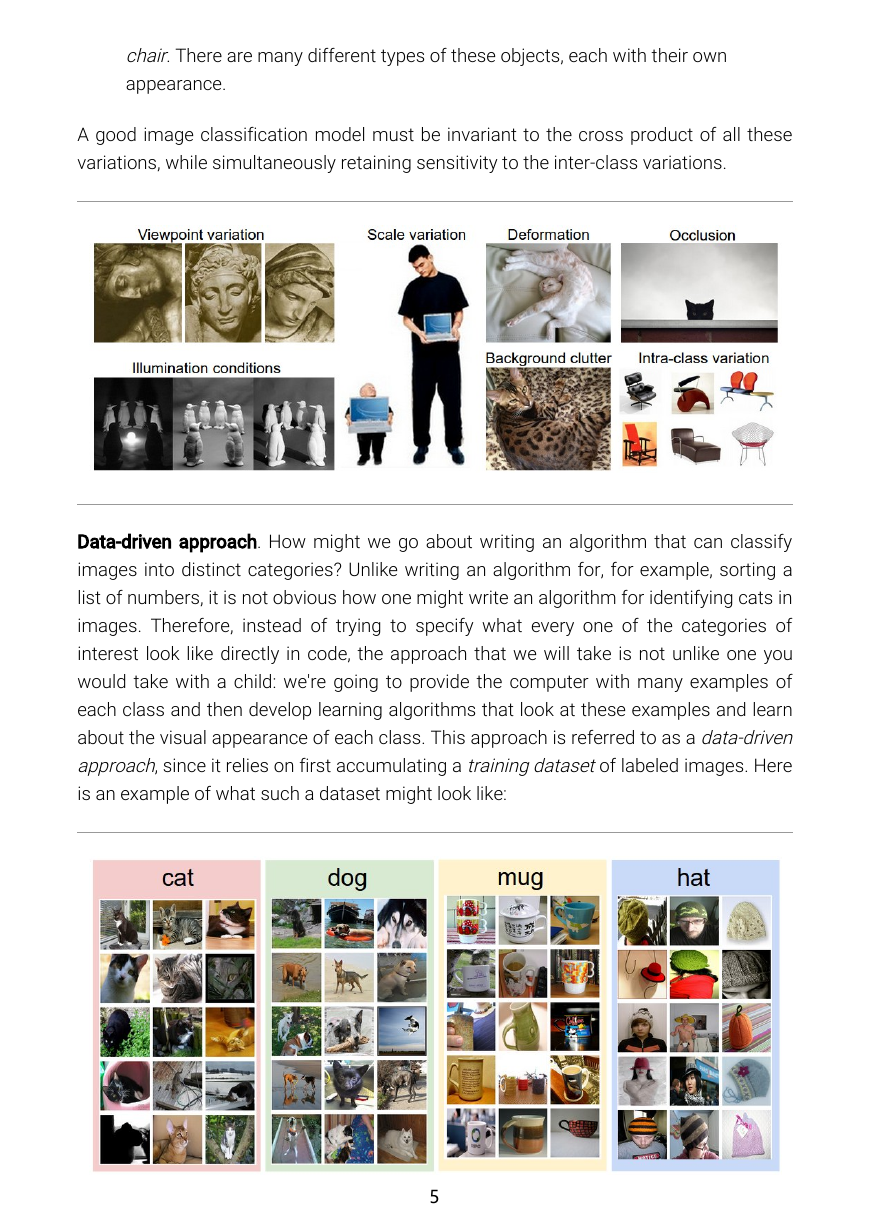









 2023年江西萍乡中考道德与法治真题及答案.doc
2023年江西萍乡中考道德与法治真题及答案.doc 2012年重庆南川中考生物真题及答案.doc
2012年重庆南川中考生物真题及答案.doc 2013年江西师范大学地理学综合及文艺理论基础考研真题.doc
2013年江西师范大学地理学综合及文艺理论基础考研真题.doc 2020年四川甘孜小升初语文真题及答案I卷.doc
2020年四川甘孜小升初语文真题及答案I卷.doc 2020年注册岩土工程师专业基础考试真题及答案.doc
2020年注册岩土工程师专业基础考试真题及答案.doc 2023-2024学年福建省厦门市九年级上学期数学月考试题及答案.doc
2023-2024学年福建省厦门市九年级上学期数学月考试题及答案.doc 2021-2022学年辽宁省沈阳市大东区九年级上学期语文期末试题及答案.doc
2021-2022学年辽宁省沈阳市大东区九年级上学期语文期末试题及答案.doc 2022-2023学年北京东城区初三第一学期物理期末试卷及答案.doc
2022-2023学年北京东城区初三第一学期物理期末试卷及答案.doc 2018上半年江西教师资格初中地理学科知识与教学能力真题及答案.doc
2018上半年江西教师资格初中地理学科知识与教学能力真题及答案.doc 2012年河北国家公务员申论考试真题及答案-省级.doc
2012年河北国家公务员申论考试真题及答案-省级.doc 2020-2021学年江苏省扬州市江都区邵樊片九年级上学期数学第一次质量检测试题及答案.doc
2020-2021学年江苏省扬州市江都区邵樊片九年级上学期数学第一次质量检测试题及答案.doc 2022下半年黑龙江教师资格证中学综合素质真题及答案.doc
2022下半年黑龙江教师资格证中学综合素质真题及答案.doc